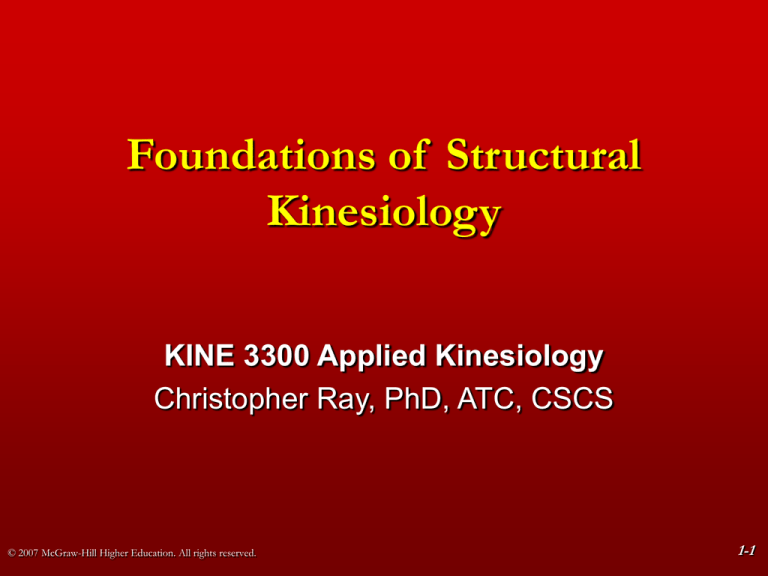
Foundations of Structural
Kinesiology
KINE 3300 Applied Kinesiology
Christopher Ray, PhD, ATC, CSCS
© 2007 McGraw-Hill Higher Education. All rights reserved.
1-1
Any Loose Ends?
© 2007 McGraw-Hill Higher Education. All rights reserved.
1-2
Talk the talk!
•
•
•
•
Directional
Location
Function
O&I
• Professional communication!
© 2007 McGraw-Hill Higher Education. All rights reserved.
1-3
Kinesiology & Body Mechanics
• Kinesiology - study of motion or human
movement
• Anatomic kinesiology - study of human
musculoskeletal system & musculotendinous
system
• Biomechanics - application of mechanical
physics to human motion
© 2007 McGraw-Hill Higher Education. All rights reserved.
1-4
Kinesiology & Body Mechanics
• Structural kinesiology - study of muscles as
they are involved in science of movement
• Both skeletal & muscular structures are
involved
• Bones are different sizes & shapes
particularly at the joints, which allow or limit
movement
© 2007 McGraw-Hill Higher Education. All rights reserved.
1-5
Kinesiology & Body Mechanics
• Muscles vary greatly in size, shape, &
structure from one part of body to another
• More than 600 muscles are found in human
body
© 2007 McGraw-Hill Higher Education. All rights reserved.
1-6
Why Kinesiology?
• should have an adequate knowledge &
understanding of all large muscle groups to
teach others how to strengthen, improve, &
maintain these parts of human body
• should not only know how & what to do in
relation to conditioning & training but also know
why specific exercises are done in conditioning &
training of athletes (BE EVIDENCE BASED)
© 2007 McGraw-Hill Higher Education. All rights reserved.
1-7
Reference positions
• Anatomical position
– most widely used & accurate for all
aspects of the body
– standing in an upright posture, facing
straight ahead, feet parallel and close,
& palms facing forward
• Fundamental position
– is essentially same as anatomical
position except arms are at the sides &
palms facing the body
© 2007 McGraw-Hill Higher Education. All rights reserved.
1-8
Anatomical directional terminology
•
Inferior (infra)
–
•
Superior (supra)
–
•
on or to the side; outside, farther from the median or
midsagittal plane
Medial
–
•
nearest the trunk or the point of origin
Lateral
–
•
situated away from the center or midline of the body, or away
from the point of origin
Proximal
–
•
above in relation to another structure; higher, cephalic
Distal
–
•
below in relation to another structure; caudal
relating to the middle or center; nearer to the medial or
midsagittal plane
Median
–
Relating to the middle or center; nearer to the median or
midsagittal plane
From Van De Graaff KM: Human anatomy, ed
6, New York, 2002, McGraw-Hill
© 2007 McGraw-Hill Higher Education. All rights reserved.
1-9
Anatomical directional terminology
© 2007 McGraw-Hill Higher Education. All rights reserved.
From Van De Graaff KM: Human anatomy, ed
6, New York, 2002, McGraw-Hill
1-10
Anatomical directional terminology
• Anterolateral
– in front & to the side,
especially the outside
• Anteromedial
– in front & toward the
inner side or midline
• Anteroposterior
• Posteromedial
– behind & to the inner
side
• Posterosuperior
– behind & at the upper
part
– relating to both
front & rear
© 2007 McGraw-Hill Higher Education. All rights reserved.
1-11
Anatomical directional terminology
• Anterior
– in front or in the
front part
• Anteroinferior
– in front & below
• Anterosuperior
– in front & above
• Posterior
– behind, in back, or in the
rear
• Posteroinferior
– behind & below; in back
& below
• Posterolateral
– behind & to one side,
specifically to the outside
© 2007 McGraw-Hill Higher Education. All rights reserved.
1-12
Anatomical directional terminology
• Contralateral
– pertaining or relating to the opposite side
• Ipsilateral
– on the same side
• Bilateral
– relating to the right and left sides of the
body or of a body structure such as the
right & left extremities
© 2007 McGraw-Hill Higher Education. All rights reserved.
1-13
Anatomical directional terminology
• Inferolateral
– below & to the outside
• Inferomedial
– below & toward the
midline or inside
• Superolateral
– above & to the outside
• Superomedial
– above & toward the
midline or inside
© 2007 McGraw-Hill Higher Education. All rights reserved.
1-14
Anatomical directional terminology
• Caudal
– below in relation to another structure;
inferior
• Cephalic
– above in relation to another structure;
higher, superior
© 2007 McGraw-Hill Higher Education. All rights reserved.
1-15
Anatomical directional terminology
• Deep
– beneath or below the surface; used to
describe relative depth or location of
muscles or tissue
• Superficial
– near the surface; used to describe relative
depth or location of muscles or tissue
© 2007 McGraw-Hill Higher Education. All rights reserved.
1-16
Anatomical directional terminology
• Prone
– the body lying face downward; stomach
lying
• Supine
– lying on the back; face upward position of
the body
© 2007 McGraw-Hill Higher Education. All rights reserved.
1-17
Anatomical directional terminology
• Dorsal
– relating to the back; being or
located near, on, or toward the
back, posterior part, or upper
surface of
• Ventral
– relating to the belly or abdomen,
on or toward the front, anterior
part of
© 2007 McGraw-Hill Higher Education. All rights reserved.
1-18
Anatomical directional terminology
• Volar
– relating to palm of the hand or sole of the
foot
• Plantar
– relating to the sole or undersurface of the
foot
© 2007 McGraw-Hill Higher Education. All rights reserved.
1-19
Web Sites
Anatomy & Physiology Tutorials:
www.gwc.maricopa.edu/class/bio201/index.htm
BBC Science & Nature
www.bbc.co.uk/science/humanbody/body/factfiles/skeleton_anat
omy.shtml
– Describes each bone and allows viewing of each from
different angles
BBC Science & Nature
www.bbc.co.uk/science/humanbody/body/interactives/3djigsaw_
02/index.shtml?skeleton
– Allows interactive placement of bone and joint structures.
© 2007 McGraw-Hill Higher Education. All rights reserved.
1-20
Web Sites
BBC Science & Nature
www.bbc.co.uk/science/humanbody/body/factfiles/joints/ball_and_
socket_joint.shtml
– Describes each type of joint and allows viewing of how the joint
moves within the body.
University of Michigan Learning Resource Center, Hypermuscle:
Muscles in action
www.med.umich.edu/lrc/Hypermuscle/Hyper.html#flex
– Describes each motion and allows viewing of the motion
performed.
Articulations
http://basic-anatomy.net/
– A thorough discussion of the articulations
© 2007 McGraw-Hill Higher Education. All rights reserved.
1-21
Web Sites
Foss Human Body
http://sv.berkeley.edu/showcase/pages/bones.html
– An interactive site which allows assembly of the skeleton
Functions of the Skeletal System
http://training.seer.cancer.gov/module_anatomy/unit3_1_bone_fun
ctions.html
– Several pages with information on bone tissue, bone
development and growth, and the joints
Wireframe Skeleton
www.2flashgames.com/f/f-220.htm
– Move around the skeleton's limbs arms legs body and make it
do funny things
Skeletal system
www.bio.psu.edu/faculty/strauss/anatomy/skel/skeletal.htm
– Pictures of dissected bones and their anatomical landmarks
© 2007 McGraw-Hill Higher Education. All rights reserved.
1-22
Web Sites
Articulations
www.douglas.bc.ca/biology/project/articulations/
– Details all of the joint types with pictures and review questions
eSkeletons Project
www.eskeletons.org/
– An interactive site with a bone viewer showing the morphology,
origins, insertions, and articulations of each bone
ExRx Articulations
www.exrx.net/Lists/Articulations.html
– Detailed common exercises demonstrating movements of each
joint and listing the muscles involved
Skeleton Shakedown
www.harcourtschool.com/activity/skel/skel.html
– Help put a disarticulated skeleton back together
© 2007 McGraw-Hill Higher Education. All rights reserved.
1-23
Web Sites
Human Anatomy Online
www.innerbody.com/image/skelfov.html
– Interactive skeleton labeling
KLB Science Department Interactivities
www.klbschool.org.uk/interactive/science/skeleton.htm
– Skeleton labeling exercises
Introductory Anatomy: Joints
www.leeds.ac.uk/chb/lectures/anatomy4.html
– Notes on joint articulations
The Interactive Skeleton
www.pdh-odp.co.uk/skeleton.htm
– Point and click to detailed skeletal illustrations
Radiographic Anatomy of the Skeleton
www.rad.washington.edu/radanat/
– X-rays with and without labels of bony landmarks
© 2007 McGraw-Hill Higher Education. All rights reserved.
1-24
Web Sites
Radiographic Anatomy of the Skeleton
www.szote.u-szeged.hu/Radiology/Anatomy/skeleton.htm
– X-rays with and without labels of bony landmarks
Virtual skeleton
www.uwyo.edu/RealLearning/4210qtvr.html
– A 3-dimensional human osteology with Quicktime movies of
each bone
Skeleton: The Joints
www.zoology.ubc.ca/~biomania/tutorial/bonejt/outline.htm
– Point and click to detailed joint illustrations
Forensic Anthropology
http://www-personal.une.edu.au/~pbrown3/skeleton.pdf
– A detailed discussion of skeletal anthropology with excellent
pictures of dissected bones
© 2007 McGraw-Hill Higher Education. All rights reserved.
1-25





